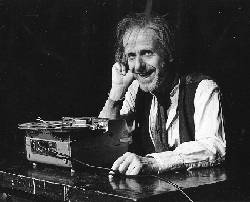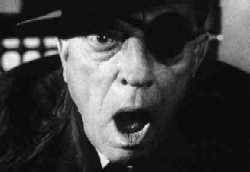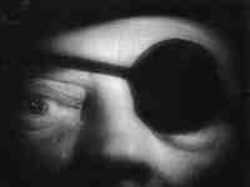
Julian Curry in Krapp's Last Tape
(photo by Porter Abbott,
Beckett Endpage) |
 |
In Krapp's Last Tape, Beckett's aging protagonist plays back and
reflects upon his own tape recorded monologue from 30 years past. Tenses are
blurred here in a new way. The on-stage tape recorder challenges theater's
traditional use of staging conventions to denote the past, a practice that
itself is a form of fiction, since all theatrical action really takes place
in the present. This use of modern technology to mix past and present in one
tableau is unprecedented in theater. Further complicating the temporal
relationships is Beckett's indication that the play takes place "in the
future".
Video has a similar capacity for ambiguity through its ability to mix
live and recorded signals, a capacity that has been exploited by a long
series of video installations beginning with Frank Gillette and Ira
Schneider's Wipe Cycle, which combines live camera feeds (of the
installation's audience) with delayed feeds and prerecorded images. I am
also reminded of Krapp's Last Tape by Ken Kobland's film
The Communists are Comfortable, in which Spalding Gray's videotaped
monologue is shown on an old television set placed inside a living room set.
The entire room, including the TV, is filmed from a fixed wide angle. The
shot lasts for several minutes during which nothing happens away from the TV
screen. In 1996 Mike Taylor used a similar concept in an intermedia piece
she conceived for 77 Hz called Dangerous
Moonlight. For this work, we built a miniature set of an empty room with
a door at one end. Behind the half-open door was a rear-projection video
screen which displayed images from 1950s noir movies. The set was
rephotographed by a video camera and mixed with live images of an actor.
This in turn was processed in real time to resemble an old black and white
television broadcast. The resulting composite of past and present was
displayed to the audience on video monitors.
Minimalism, by avoiding the closure of completeness or comprehensiveness,
is quintessential open-system thinking. And the parallels between Beckett
and minimalist cinema are unmistakable. In Breath, Beckett's shortest
play, the curtain opens and closes on a stage occupied only by dimly lit
garbage. There is no action, and no sound except a faint offstage cry and a
single amplified human breath. The static tableau in cinema is of obvious
importance over the past few decades: think of virtually any piece by Bill
Viola, for example.
Beckett's work is notable for the frequent disparity between the visual
and aural rate of information. At one extreme are his wordless plays (Act
Without Words I and II, Quad, etc.), which can be
approached from the tradition of mime and dumb plays. At the other extreme
are plays that feature extensive monologue or dialogue, but virtually no
staged action at all. A good example is That Time, in which a spotlit
face is seen listening to its own voice emanating via loudspeaker from
different points in the auditorium. The face itself never speaks, and its
stage directions consist solely of blinking, breathing audibly and, at the
very end, smiling. A cinematic counterpart to this is Mike Hoolboom's
wonderful film The White Museum, which begins with 28 minutes of
white leader accompanied by a sound collage dominated by a voice-over, and
ends with a 7-minute high contrast black and white shot of a forest
accompanied by Mozart's Requiem. Another counterpart is Frampton's
Zorns Lemma, specifically its visually static but aurally complex
beginning and ending sections.
Beckett himself wrote several treatments for film and video. They have
received little consideration as models of experimental cinema, perhaps
because they are essentially photographed theater, shot in proscenium-style
sets (Film,
featuring Buster Keaton, is exceptional for using outdoor footage and a
fully enclosed interior set). Nevertheless, these works convey distinct
formal traits that have since become characteristic of the cinematic
avant-garde. Eh Joe, a television play written in 1965, resembles
That Time, since the only visible character, a middle-aged man, is
silent throughout. Virtually the entire film is spent on a gradually
tightening close-up of his face as sits on his bed listening to the faint
whispers of an unseen female voice. Although we are not told so in as many
words, the voice seems to be that of his dead wife. Periodically the voice
pauses, and Joe begins to fall asleep. As the camera moves closer, he is
reawakened by her resumed taunts. The process goes on without cutaways for
20 minutes. Finally, the voice becomes inaudible, and the picture slowly
fades to black. Eh Joe is not as long as Warhol's Sleep
(completed two years earlier), or Snow's Wavelength (completed two
years later), but the similarity is clear, and has not been generally
acknowledged in writings on early minimalist cinema. |


